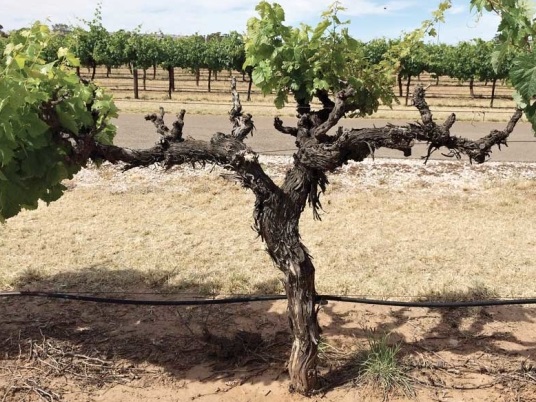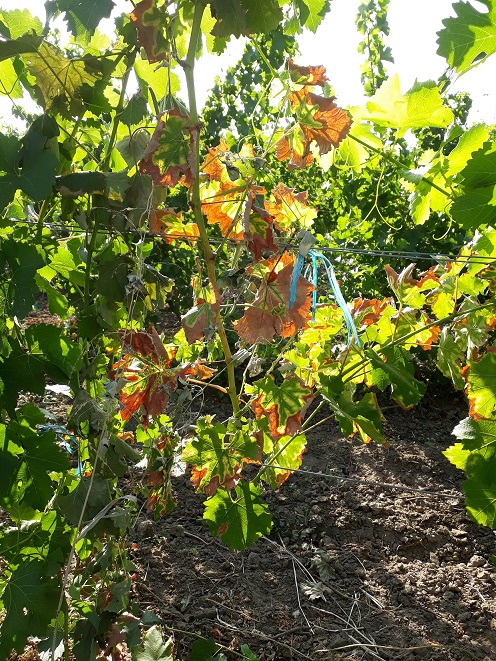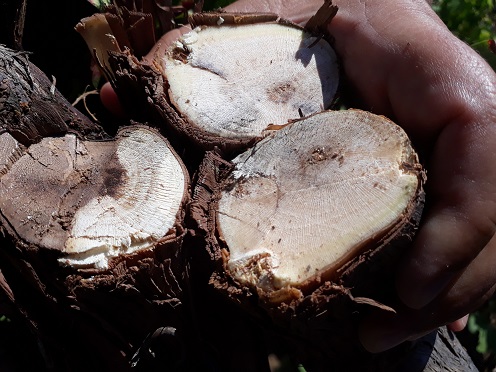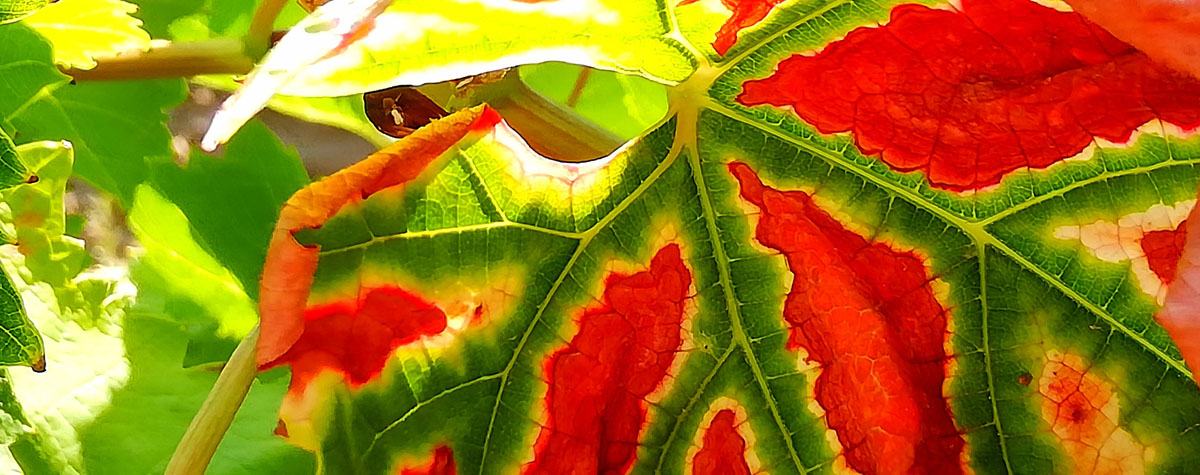Early research
Eventually the insect cause was proposed by Jules Planchon, a French botanist from the University of Montpellier. His theory that the insect causing this root damage was the source of vine death was eventually confirmed by Charles Riley, the state entomologist for Missouri. He knew that the European grapevine Vitis vinifera could not tolerate root attacks by the Phylloxera aphid; he also knew that by grafting onto the native American vines Vitis labrusca that the problem could be solved. The native vines were resistant to the native pest, good logic according to Charles Darwin’s recently published book regarding evolution.By the 1880s, the grafting of vinifera onto American rootstock was becoming more common, although the initial selections of American vines were not suited to the calcareous soils of some parts of France. TV Munson, horticulturist and grape breeder of Texas, was engaged to locate and supply cuttings of more appropriate species. By the time of the 1881 International Phylloxera Congress in Bordeaux, grafting to American rootstock had won the day as the solution to the phylloxera problem, although some people still preferred elimination using chemicals, others by crossing American species and vinifera varieties.
Phylloxera today
Phylloxera has been spread globally along with grapevine, and now can be found throughout Europe and most New World vineyards. Phylloxera is, however, not present in Chile, nor in every vine growing region of Australia and Argentina.Grafting grapevines to resistant rootstock is one of the best examples of biological control to be found in agriculture. There are now multitudes of rootstock in use, some specifically bred, and the soil and climate requirements of each are generally well known. Because of this commercial control, phylloxera is not the threat that was feared in France in the 1870s.
And trunk disease could be worse than the original threat of phylloxera?
Quite so, yet many in the wine industry are unaware of the presence of this disease in their vineyards even today, nor do they know how to control it!'Grapevine Trunk Diseases are a substantial threat to world viticulture'It is only in the last 30 years or so that Grapevine Trunk Diseases (GTD) have been acknowledged as important, and even more recently still as a substantial threat to world viticulture. There is clear evidence that the incidence of trunk disease is increasing in many vineyard regions of the world. Some trunk disease experts predict that the disease is probably present in every one of the world’s vineyards. Certainly, since I have learned to recognise the symptoms in 2011, I have not been in a vineyard anywhere since where I have failed to find symptoms, which includes visits to vineyard regions in over 20 countries including the tropics.

Trunk diseases are caused by fungi
There are four principal groups of the disease which occur widely and affect mature vines. These are known as Esca, as Eutypa dieback, as Botryosphaeria dieback and as Phomopsis dieback, also known as Excoriose or deadarm. The two major diseases affecting young vines are Black Foot and Petri Disease (“Black Goo”).Each of these diseases has a range of characteristic symptoms, some of these in common. Eutypa, Botryosphaeria and Phomopsis all produce wedge-shaped cankers in the cordons and trunks. Botryosphaeria, Eutypa and Phomopsis also cause dead spurs and cordons (above). Eutypa has very characteristic early spring shoot growth symptom, and Esca (below, in a Sauvignon Blanc vine) has very distinctive foliar symptoms in midsummer which are induced by drought. Mid-summer apoplexy, the wilting of shoots and fruit is another common symptom.

The lifecycle and epidemeology of trunk diseases is quite similar, apart from that for Black Foot, which is soil-inhabiting. The important issue about trunk disease is that they are insidious and symptoms take several years to develop after infection. So the disease can be spreading within and among vines in the vineyard before the vigneron may be aware of its presence. There is a parallel with some cancers in humans.
Pruning wounds are the principal point of entry of infecting spores, although mechanical and frost injury also permit infection. Fruiting bodies are present in the dead wood of infected vines, and are released by rainfall, and dispersed by wind and splash.
Management and control of trunk diseases
There are two principal methods of control of trunk diseases. The first is to cover winter pruning wounds with protective fungicides and barrier products. The availability of such treatment products varies from country to country depending on the registrations: there are presently none registered in Canada, but there are many alternatives available to growers in California, Australia and New Zealand. Mostly these are chemical fungicides, some are microbial products.Application can be by hand spray or painting or by machine sprayer, and growers are encouraged to make application as soon as possible after pruning. Another approach which is used in regions with distinct rainfall patterns is to vary pruning times.
The second line of defence is to use trunk renewal, that is to train suckers (watershoots) from the base of the trunk to form a replacement trunk and cordons. This is an established practice to overcome winter freeze injury to trunks. This should be done before the fungal infection has moved downwards to the base of the trunk, so that the new trunk is free from the disease. That is, the new vine is “rejuvenated” in the true sense of the word.
My advice to growers is to begin trunk renewal when the first symptoms are seen in a young vineyard, and this may be done in proximity to the symptomatic vine. For older vineyards I suggest making a quick survey of the extent of symptoms and progress of the disease down the trunk before deciding on a course of action. For old, infected vineyards removal may be necessary. Shown below are typical symptoms of trunk disease.

Back to phylloxera and trunk disease comparisons
Today’s scientists have much better tools to understand the complexity of trunk diseases and the vine’s response than those available 160 years ago. The control of phylloxera by grafting on resistant rootstock is now well understood and accepted throughout the world. The situation for trunk disease could not be more different. It is present in many vineyards, likely the majority globally. The application of management procedures to reduce the spread of infection is limited to a few countries with comprehensive research and extension programs, like western USA, South Africa, Australia and New Zealand. And so the disease continues to spread in both young and old vineyards. This is a particular worry in Europe.Adding insult to injury is the sad fact that grapevine nurseries around the world are producing disease-infected grafted vines. So, a grower may remove a vineyard which is uneconomic because of trunk disease and unknowingly replace it with young vines infected with the same disease. Good sustainable business for the nurseries, but not for vine growers!
A few weeks ago we celebrated the 50th anniversary of the landing of men on the moon. And yet we cannot apparently produce disease-free young grapevine plants for what is the world’s largest fruit crop. Such is the sad state of awareness and research investment in the grape and wine sector.
Canopy readers, do you have trunk disease in your vineyards? Are you sure? Importantly, what are you doing about it?
Dr Richard Smart is an experienced viticultural scientist and consultant. He can be contacted using vinedoctor@smartvit.com.au
Reference
1. Grapevine Trunk Diseases, a Review. De la Fuente, M. et al. (2016). OIV Publications.













.png)






